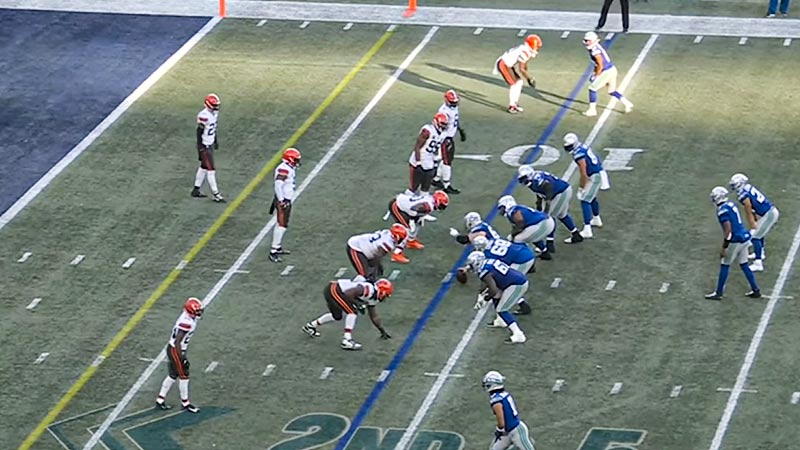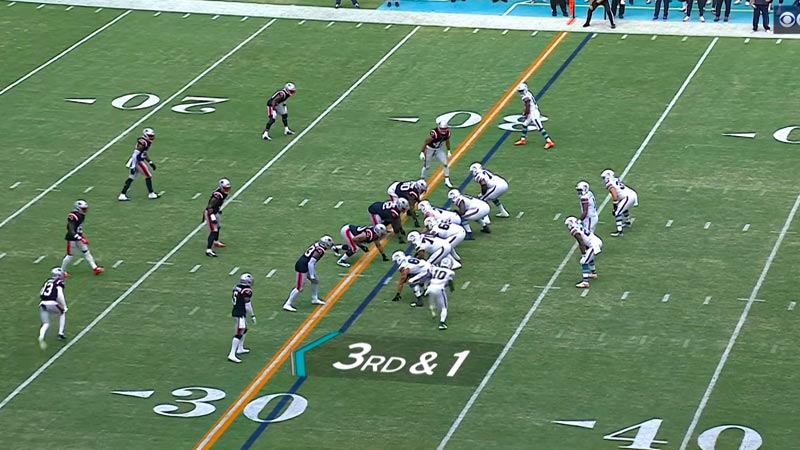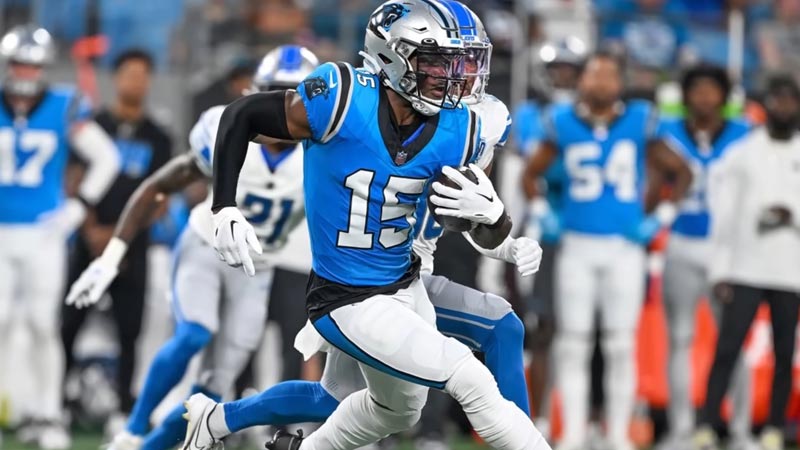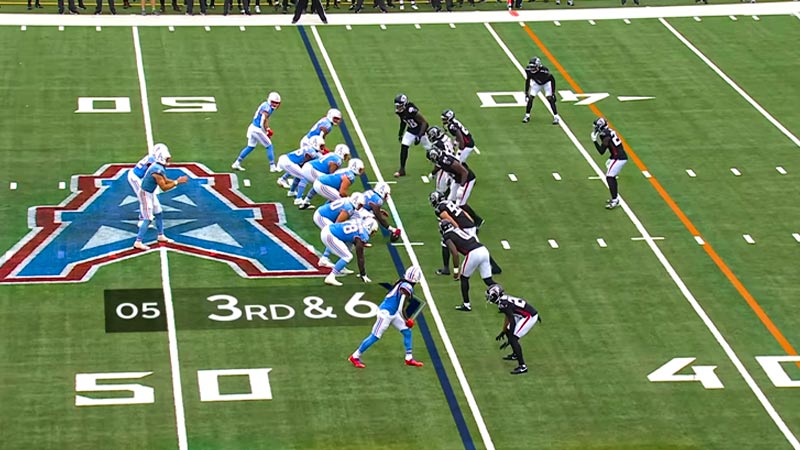Zone defense in American football is a sophisticated and strategically vital aspect of the game. This defensive strategy has been honed and refined over decades, evolving to counter the ever-changing offensive tactics of the sport.
In our exploration of “American Football Zone Defense,” we will delve into the inner workings of this defensive system, breaking down its key components, strategies, and tactics.
This blog post will provide an in-depth look at the strengths and weaknesses of zone defense, its historical evolution, and its relevance in today’s game.
We’ll explore the role of pattern matching, communication, and adaptability in executing an effective zone defense.
From understanding the various zone coverages to learning when and how to employ them, we will equip you with the knowledge to appreciate and utilize zone defense to its full potential. Stay sharp.
What Is American Football Zone Defense?
American football zone defense is a defensive strategy employed by a team to protect against passing plays.
In this approach, the defensive players are responsible for covering specific areas of the field rather than individual offensive players. Each defender is assigned a “zone” or region of the field to monitor.
This allows them to react to the movements of offensive players within their designated zone, making it challenging for the opposing quarterback to find open receivers.
Zone defense is particularly effective against passing attacks, as it can create tight coverage and disrupt passing lanes. It also helps defenders react to the ball more quickly, potentially leading to interceptions.
However, it can leave gaps between zones, which savvy quarterbacks and receivers may exploit. Coaches often use a combination of man-to-man and zone defenses to keep the opposing offense off balance.
Zone defense is a fundamental aspect of American football’s strategic playbook, requiring communication, discipline, and teamwork among the defensive players.
Evolution of Zone Defense in American Football

The evolution of zone defense in American football has been a dynamic and strategic process that has significantly shaped the game.
Here are some key developments in the evolution of zone defense:
Early Zone Concepts
Zone defense has been part of football since its early days in the late 19th century, but it was relatively rudimentary compared to modern strategies.
Defenders were often assigned areas to cover, but the concept was not as refined as it is today.
The “Umbrella Defense”
In the mid-20th century, coaches like Bud Wilkinson and Tom Landry popularized the “Umbrella Defense.”
This was a precursor to modern zone defense, with defensive backs responsible for specific zones in the passing game.
The development of this strategy was a response to the growth of the passing game.
Innovations by the 46 Defense
In the 1980s, the Chicago Bears’ 46 Defense, designed by Buddy Ryan, made significant use of zone concepts.
It placed an emphasis on pressuring the quarterback and used a tight formation to create an aggressive version of zone defense.
Zone Blitz Schemes
Zone defense continued to evolve with the introduction of zone blitz schemes in the 1990s and 2000s.
These schemes combined zone coverage with aggressive blitzes, creating confusion for quarterbacks and offensive lines.
Match Coverage and Variations
Modern zone defense includes various types of zone coverages, such as Cover 2, Cover 3, and Cover 4, each with its own nuances.
Additionally, match coverage concepts have emerged, which allow defenders to switch from zone to man coverage based on the routes of the offensive players.
Hybrid Defenses
Many teams now employ hybrid defenses that combine elements of zone and man coverage, adapting to the strengths of their personnel and the specific challenges posed by opponents.
Use of Analytics and Technology
In recent years, the NFL has seen an increased use of data analytics and video technology to optimize zone defense strategies.
Teams analyze opponent tendencies and player performance to refine their defensive game plans.
Ongoing Adaptation
The evolution of zone defense in American football is ongoing.
Defensive coordinators continue to adapt to the ever-changing offensive strategies, using zone as a foundational element while incorporating new variations and concepts to counteract high-powered passing attacks.
Zone defense in American football has evolved from basic area assignments to a complex and strategic component of the game.
Key Components of Zone Defense

Zone defense in American football relies on several key components that are crucial to its success.
These components are essential for defenders to effectively cover designated areas on the field and disrupt passing plays. Here are some key components of zone defense:
Zone Assignments
Defenders are responsible for specific zones on the field, often determined by the defensive play call. These assignments may vary depending on the coverage called (e.g., Cover 2, Cover 3, Cover 4).
Clear communication and understanding of each player’s zone responsibilities are fundamental.
Field Awareness
Players in a zone defense must have a strong understanding of the field’s dimensions and their assigned areas.
This awareness allows them to maintain proper spacing and prevent open passing lanes. It also helps them anticipate and react to the actions of the opposing offense.
Read and React
Zone defenders need to read the quarterback’s eyes, recognize receiver routes, and react to the developing play.
They must strike a balance between staying disciplined in their zone and reacting to the football once it’s thrown, making interceptions or tackles.
Depth and Width
The depth and width of a defender’s zone can vary, and players must maintain the appropriate positioning relative to the line of scrimmage and the sidelines.
Proper alignment prevents both deep passes and sideline routes from being effective.
Pattern Matching
In more sophisticated zone defenses, players may employ a technique called pattern matching.
This involves defenders identifying and matching the routes of receivers entering their zones, transitioning from zone to man coverage as the situation demands.
Zone Drops and Zone Awareness
Linebackers and defensive backs must execute zone drops, moving backward to maintain their assigned areas while keeping their eyes on the quarterback.
They also need to be aware of threats entering their zones, including receivers and potential blockers.
Zone Overlaps and Communication
In zone defense, it’s common for defenders to have overlapping responsibilities. Proper communication between defenders is essential to ensure that no areas are left uncovered.
Players should inform their teammates about any offensive players entering or leaving their zones to prevent coverage breakdowns.
Zone defense is a complex system that relies on players working together to collectively cover the entire field, making it challenging for the offense to find open receivers.
Strategies and Tactics of Football Zone Defense

The strategies and tactics of football zone defense are crucial in creating a strong and effective defensive system. Here are some elaborate points that outline these key components:
Coverage Variations
Zone defense comes in various forms, such as Cover 2, Cover 3, and Cover 4, each with its specific strengths and weaknesses.
Coaches must choose the right coverage based on the opponent’s offensive tendencies and the situation.
For example, Cover 2 provides two-deep safeties for preventing deep passes, while Cover 3 relies on three deep defenders to protect against vertical routes.
Pass Rush and Pressure
An effective pass rush complements zone defense by disrupting the quarterback’s timing.
Defensive linemen and linebackers may use tactics like stunts and blitzes to create pressure while the secondary maintains coverage. This combination can lead to hurried throws, sacks, and turnovers.
Formations and Alignment
The initial positioning of defensive players is critical. Coaches determine where each player lines up before the snap to optimize coverage and create potential traps for quarterbacks.
Players should be well-schooled in their alignments and understand how they fit into the overall defensive scheme.
Pattern Matching
Some zone defenses incorporate pattern matching, which involves defenders reacting to the routes of receivers within their zones.
This tactic allows defenders to transition into man coverage when necessary, reducing the likelihood of receivers finding openings in the zones.
Disguise and Pre-snap Movement
Pre-snap disguise is a strategic element of zone defense. Defenders may shift, rotate, or show different looks to confuse the quarterback and offensive line.
These movements can create uncertainty and force the offense to adjust its play call.
Zone Coverage Techniques
Defenders in zone coverage must employ specific techniques, such as “squatting” to react to short routes or “sinking” to defend against deep passes.
These techniques are designed to maximize the effectiveness of zone coverage while minimizing the risk of big plays.
Communication and Responsiveness
Effective communication is a cornerstone of zone defense. Players need to relay information about route developments, receiver threats, and any potential adjustments to teammates.
Responsiveness to these communications and the ability to adapt to the flow of the play are vital for success.
Zone defense is about teamwork, discipline, and understanding the opponent’s tendencies. It aims to disrupt the passing game, create turnovers, and limit big gains.
Pros and Cons of Zone Defense
Zone defense in American football has its own set of advantages and disadvantages, which can vary depending on the situation and how well it is executed.
Here are the pros and cons of using zone defense:
Pros of Zone Defense
- Pass Coverage: Zone defense is particularly effective at covering passing routes and protecting against deep throws. It can create multiple layers of coverage, making it challenging for quarterbacks to find open receivers.
- Interception Opportunities: Zone defenders have the opportunity to read the quarterback’s eyes and react to the ball, increasing the chances of interceptions. They can jump routes and take advantage of errant throws.
- Balanced Coverage: Zone defenses provide balanced coverage across the field, reducing the risk of leaving a receiver wide open. This can be especially effective in preventing big plays.
- Teamwork: Zone defense relies heavily on teamwork and communication. Players work together to cover areas of the field, making it difficult for the offense to exploit individual matchups.
- Adaptability: Zone defenses can be adjusted to counter specific offensive schemes or game situations. Defenders can shift their coverage emphasis based on the opponent’s tendencies.
Cons of Zone Defense
- Vulnerability to Quick Passes: Short, quick passes can exploit gaps in zone coverage, especially if defenders are slow to react. This can result in yards after the catch and sustained drives.
- Leaving Holes: Zone defenses inherently leave gaps between the zones, which smart quarterbacks and skilled receivers can exploit. They may find soft spots in the coverage and exploit them with well-timed throws.
- Communication Errors: Zone defense relies on effective communication among defenders. Any breakdown in communication can result in blown coverages and open receivers.
- Mismatch Issues: Zone defense can lead to mismatches, particularly if slower defenders are responsible for covering faster offensive players. This can create opportunities for big plays if the offense identifies and exploits these mismatches.
- Limited Pass Rush: Zone defenses may not put as much pressure on the quarterback as man-to-man defenses or blitz-heavy schemes. This can give the quarterback more time to find receivers downfield.
- Predictability: Overreliance on zone defense can make a defense predictable, allowing skilled offensive coordinators to design plays specifically to beat zone coverage.
Zone defense can be an effective strategy when executed well, especially against passing-heavy offenses.
However, it has its weaknesses, such as vulnerabilities to short passes and the need for precise communication.
FAQs
What is American football zone defense?
American football zone defense is a defensive strategy where defenders are responsible for covering specific areas (zones) of the field rather than individual offensive players.
It’s used to disrupt passing plays, protect against deep throws, and create balanced pass coverage.
How do players coordinate in zone defense?
Players in zone defense must communicate to cover their assigned areas, adapt to offensive movements, and read the quarterback’s intentions.
Communication and teamwork are essential to maintain effective coverage.
What are the advantages of zone defense?
Zone defense excels at pass coverage, interception opportunities, balanced coverage, and adaptability to counter-specific offenses. It relies on teamwork and can disrupt the opponent’s passing game.
What are the drawbacks of zone defense?
Zone defense may be vulnerable to quick passes, miscommunications, mismatches, and limited pass rush.
It can also be predictable if overused, making it easier for opponents to exploit weaknesses.
When should a team use zone defense in American football?
Zone defense is effective against passing offenses and in situations where preventing big plays is a priority.
It’s often used in long-yardage situations, goal-line defense, and when a defense wants to limit deep passes.
Wrapping Up
American football zone defense is a dynamic and adaptable strategy that plays a pivotal role in modern defensive schemes.
Its evolution, from its early roots to the complex variations used today, showcases its enduring significance.
By comprehending the strategies and tactics discussed in this blog post, coaches, players, and enthusiasts can enhance their appreciation of zone defense and its role in shaping the game of American football.
Whether it’s preventing deep passes, or creating balanced coverage, zone defense remains an invaluable weapon in the defensive playbook, offering the potential to disrupt offensive schemes. Thank you so much.







